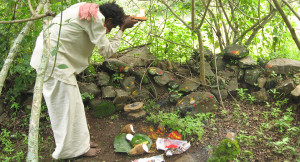
The Sacred Natural Sites Initiative regularly features “Conservation Experiences” of custodians, protected area managers, scientists and others. This post features the experiences of Ms. Sushmita Mandal and her colleagues at ATREE who have supported the Soliga with mapping their sacred natural sites in order to gain recognition of their local governance systems and forest stewardship practices. Ms. Sushmita Mandal

A Soliga paying his obeisance at a Devaru site in BRTWS
Note: Such found structures as a cluster of stones, in this case, and an unusually shaped tree are accorded sacred status and worshipped. Source: Nitin D. Rai
and her colleagues captured their and the Soliga’s efforts in a book chapter which you can download from the resource section of the full case study. In addition you can also find more in depth analysis of the implications of the Forest Rights Act for indigenous peoples in India, including the Soliga. Click here to read the full case study: “Conservation Experience: Soliga communities map Sacred Natural Sites in a wildlife sanctuary in Karnataka India.”
The Biligiri (white hill) Rangaswamy Temple Wildlife Sanctuary (BRTWS) covers an area of 540 km2 with on top of its major hill the temple of Lord Rangaswamy, a resting form of Lord Vishnu, deity of the forests. The declaration of the BRTWS as a protected site came with a set of restrictions such as access, hunting and burning for the traditional inhabitants, the Soligas which the government deemed a threat to the local biodiversity ands subsequently displaced forest dwellers to locations outside of protected areas.
Aren’t we, the native dwellers of the forests who have been practicing litter-fires, managing to conserve biodiversity? What have so-called civilized urban dwellers contributed towards it? Source: Anonymous Soliga.
Soligas, see their actions as an age-old tradition that supports local biodiversity values. Even though sacred natural sites in these areas are often seen as separate elements in the landscape, they form a cultural-ecological mosaic of interconnected places long recognised and protected by the Soligas. Soligas say that they maintain balance of the forest ecology which in turn provides security to their traditional lifestyles but with the law against them the managers of BRTWS take little notion of the role of human agency in these forests.
Read the full case study to find out how Soliga are using traditional knowledge and mapping techniques for the recognition and maintenance of their Sacred Natural Sites and territories.






